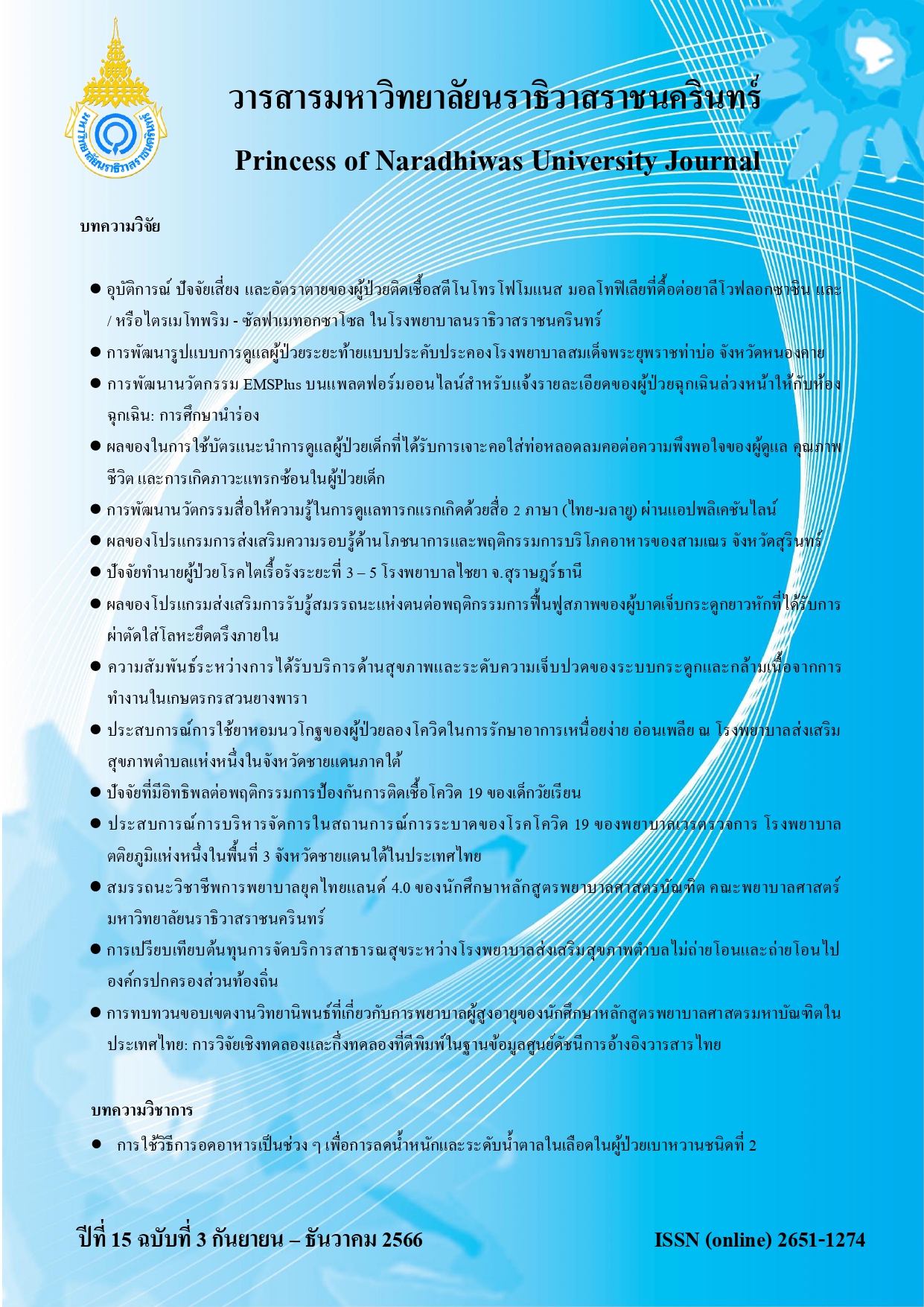Incidence, risk factors, and mortality rate of patients with Levofloxacin or Trimethoprim-sulfamethoxazole-nonsusceptible Stenotrophomonas maltophilia bacteria at Naradhiwas Rajanagarindra Hospital
Keywords:
Stenotrophomonas maltophilia, Trimethoprim-sulfamethoxazole, LevofloxacinAbstract
A five-year retrospective study was conducted from October 1, 2017 to September 30, 2022. Sample of this study was patients from Naradhiwas Rajanagarindra hospital who were older than 15 years old. It was discovered that these patients had a significantly higher incidence of Stenotrophomonas maltophilia bacterium infection (p0.001). According to the findings, the average age of the participants was 57.5 years. 92.8 percent of the subjects have a history of getting antibiotics through vein. The average length of stay in the hospital was 31.6 days. Almost all of them had a respiratory infection (80.5%) and a greater rate of intubation (77.3%) following by a urinary tract infection (7.6%). The most common comorbidity diseases were cerebral vascular disease (21.2), coronary artery disease (17.3), and chronic kidney disease (13.5). Levofloxacin or trimethoprim-sulfametoxasol were the most often utilized antibiotics, with a medication non-susceptibility rate of 19.2%. Prolonged hospital stay was a risk factor for developing medication resistance (p=0.013). Participants who did not acquire drug non-susceptibility had an average hospital stay of 30.5 days, whereas those who did develop drug non-susceptibility had an average hospital stay of 42.4 days. Those with infection who did not acquire non susceptible had a 31% of mortality rate, while those with infection plus drug non susceptible had a 48.7% of mortality rate. As a result, drug non-susceptibility is a significant risk factor for greater mortality rate (p=0.038) and has 1.5 times of the risk factors comparing with participants who do not have drug non-susceptibility.
References
Adegoke, A. A., Stenström, T. A., & Okoh, A. I. (2017). Stenotrophomonas maltophilia as an emerging ubiquitous pathogen: Looking beyond contemporary antibiotic therapy. Frontiers in Microbiology, 8, 2276.
Biagi, M., Tan, X., Wu, T., Jurkovic, M., Vialichka, A., Meyer, K., & Wenzler, E. (2020). Activity of potential alternative treatment agents for Stenotrophomonas maltophilia isolates nonsusceptible to levofloxacin and/or trimethoprim-sulfamethoxazole. Journal of Clinical Microbiology, 58(2). e01603 - 19.
Denet, E., Vasselon, V., Burdin, B., Nazaret, S., & Favre-Bonté, S. (2018). Survival and growth of Stenotrophomonas maltophilia in free-living amoebae (FLA) and bacterial virulence properties. PlOS One, 13(2), e0192308.
Flores-Treviño, S., Bocanegra-Ibarias, P., Camacho-Ortiz, A., Morfín-Otero, R., Salazar-Sesatty, H. A., & Garza-González, E. (2019). Stenotrophomonas maltophilia biofilm: its role in infectious diseases. Expert Review Anti-Infective Therapy, 17(11),877–893
Gil-Gil, T., Martínez, J. L., & Blanco, P. (2020). Mechanisms of antimicrobial resistance inStenotrophomonas maltophilia: a review of current knowledge. Expert Review of Anti-Infective Therapy, 18(4), 335–347.
Herrera-Heredia, S. A., Pezina-Cantú, C., Garza-González, E., Bocanegra-Ibarias, P., Mendoza-Olazarán, S. … Flores-Treviño, S. (2017). Risk factors and molecular mechanisms associated with trimethoprim-sulfamethoxazole resistance in Stenotrophomonas maltophilia in Mexico. Journal of Medical Microbiology, 66(8), 1102–1109.
Insuwanno, W., Kiratisin, P., & Jitmuang, A. (2020). Stenotrophomonas maltophilia infections: Clinical characteristics and factors associated with mortality of hospitalized patients. Infection and Drug Resistance, 13, 1559–1566.
Jian, J., Xie, Z., & Chen, L. (2022). Risk factors for mortality in hospitalized patients with Stenotrophomonas maltophilia bacteremia. Infection and Drug Resistance, 15, 3881–3886.
Matson, H. H., Jones, B. M., Wagner, J. L., Motes, M. A., & Bland, C. M. (2019). Growing resistance in Stenotrophomonas maltophilia. American Journal of Health-System Pharmacy: AJHP: Official Journal of the American Society Health-System Pharmacists, 76(24), 2004–2005.
Narathiwas Rajanagarindra Hospital. (2022). Report on the susceptibility pattern of bacteria to monthly antibiotics. Jan.-Jun. 2022, Narathiwas Rajanagarindra Hospital. (in Thai)
Nair, A. P., Sasi, S., Al Maslamani, M., Al-Khal, A., Chacko, K., Deshmukh, A., & Abukhattab, M. (2022). Clinical and epidemiological characteristics of Stenotrophomonas maltophilia associated lower respiratory tract infections in Qatar: A retrospective study. Cureus, 14(3), e23263.
Palleroni, N. J., & Bradbury, J. F. (1993). Stenotrophomonas, a new bacterial genus for Xanthomonas maltophilia (Hugh 1980) Swings et al. 1983. International Journal of Systematic Bacteriology, 43(3), 606–609.
Sader, H. S., Castanheira, M., Mendes, R. E., & Flamm, R. K. (2018). Frequency and antimicrobial susceptibility of Gram-negative bacteria isolated from patients with pneumonia hospitalized in ICUs of US medical centers (2015-17). The Journal of Antimicrobial Chemotherapy, 73(11), 3053–3059.
Sarzynski, S. H., Warner, S., Sun, J., Matsouaka, R., Dekker, J. P., Babiker, A., & Kadri, S. S. (2022). Trimethoprim-sulfamethoxazole versus levofloxacin for Stenotrophomonas maltophilia infections: A retrospective comparative effectiveness study of electronic health records from 154 US hospitals. Open Forum Infectious Diseases, 9(2), ab644.
Thomas, R., Hamat, R. A., & Neela, V. (2014). Extracellular enzyme profiling of Stenotrophomonas maltophilia clinical isolates. Virulence, 5(2), 326–330.
Trifonova, A., & Strateva, T. (2019). Stenotrophomonas maltophilia - a low-grade pathogen with numerous virulence factors. Infectious Diseases (London, England), 51(3), 168–178.
Wang, C. H., Yu, C.-M., Hsu, S.-T., & Wu, R.-X. (2020). Levofloxacin-resistant Stenotrophomonas maltophilia: risk factors and antibiotic susceptibility patterns in hospitalized patients. The Journal of Hospital Infection, 104(1), 46–52.
Wang, N., Tang, C., & Wang, L. (2021). Risk factors for acquired Stenotrophomonas maltophilia pneumonia in intensive care unit: A systematic review and meta-analysis. Frontiers in Medicine, 8, 808391.
Watson, L., Esterly, J., Jensen, A. O., Postelnick, M., Aguirre, A., & McLaughlin, M. (2018). Sulfamethoxazole/trimethoprim versus fluoroquinolones for the treatment of Stenotrophomonas maltophilia bloodstream infections. Journal of Global Antimicrobial Resistance, 12, 104–106.
Downloads
Published
How to Cite
Issue
Section
License
Copyright (c) 2023 Princess of Naradhiwas University Journal

This work is licensed under a Creative Commons Attribution-NonCommercial-NoDerivatives 4.0 International License.




